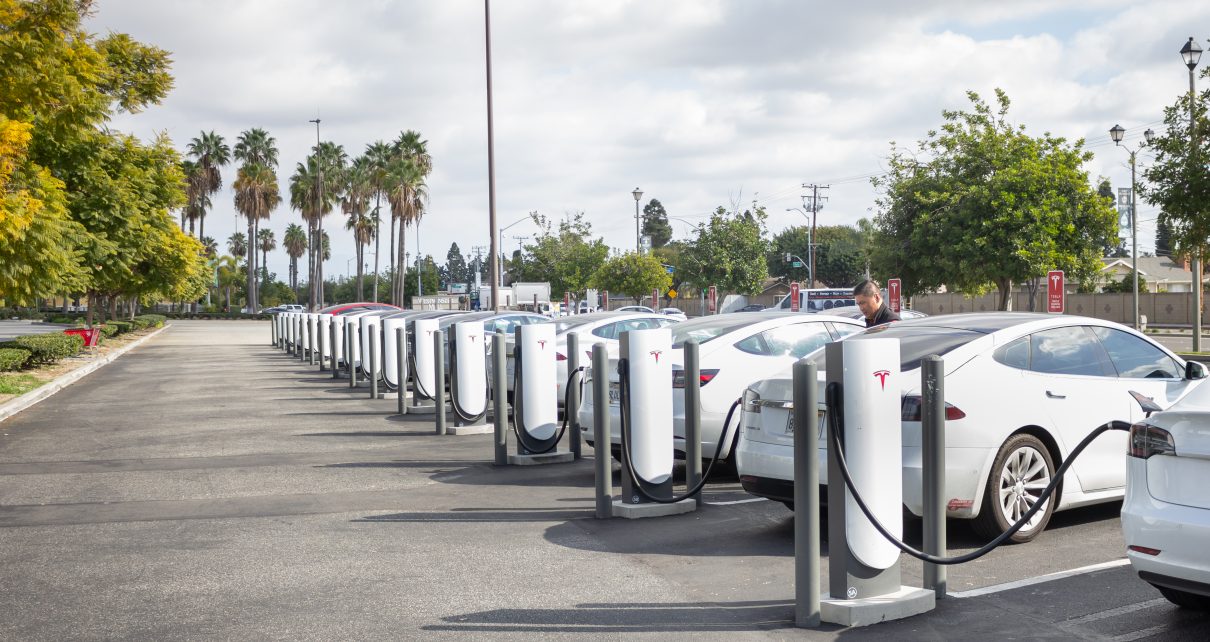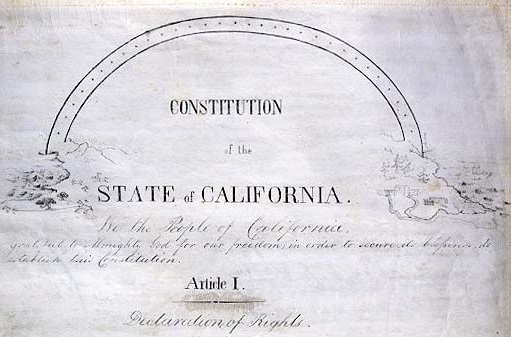
A Tesla Supercharger pump station at the Westminster Mall parking lot. (Photo: The Image Party, Shutterstock)
Prop. 30 Splits California’s Ruling Elite
If it passes, taxpayers will pour tens of billions into EV technology that will be obsolete within a decade or two
By Edward Ring, September 25, 2022 2:30 am
Even by national standards, state ballot initiative campaigns in California are big time politics. You can run a campaign for U.S. Senator in most states in America for less than it costs to qualify and successfully campaign to pass a statewide ballot initiative in California. Political insiders in Sacramento describe any controversial initiative with well funded antagonists as a “war.” And if politics is war by other means, they’re right. The latest war is over Prop. 30, the “Clean Cars and Clean Air Act.”
What’s unusual about Prop. 30, however, is how it has split California’s ruling elite. On the side in favor of Prop. 30, you have billionaire Democrats, a powerful corporation that promotes itself as both woke and green, and the firefighters union. Opposing Prop. 30 are Governor Newsom and the California Teachers Association, and to fund their opposition campaign, an assortment of individuals and organizations that defy categorization other than to say that Newsom and the CTA have picked some surprising bedfellows.
In this battle of juggernauts, and in a twist of politics that is exceedingly rare, the CTA is up against a bigger and stronger bully.
The best way to get recent information on campaign spending in California is on the Secretary of State’s Campaign Finance website under “Propositions and Ballot Measures.” Since the only money that matters in a state ballot initiative is big money, select “Proposition 30,” then for each committee listed, click on the “Late and $5,000+ Contributions Received” link. This will give you information on every major contribution up to 10 days ago.
The primary force behind Prop. 30 is Lyft, which has already dumped $25 million into the Yes on 30 campaign. This represents over 90 percent of the funding so far, and if their battle to rewrite AB 5 back in 2020 is any indication, Lyft is prepared to spend the opposition into the ground.
Joining Newsom and the CTA in opposition to Prop. 30 is the uncreatively named “No on 30” committee, with major donations so far totaling $11.4 million. The big donors include individuals whose giving history puts them all over the map: Libertarians, Never Trump Republicans, and Democrats. Motivations must vary. No new taxes? Not another subsidy? Business or ideological concern with Lyft’s agenda?
Also opposing Prop. 30 with $1 million in contributions is “Govern California,” a centrist PAC – emulating the public sector union model – that has 18 chapters spread around the state. This enables mega-donors to contribute to each chapter, then each chapter donates to an assortment of candidates targeted for support. The practical effect of this is that instead of a donor being constrained by the individual maximum donation they can make to a candidate, that maximum is magnified by the number of Govern for California chapters they support which in-turn donate to that candidate. Brilliant.
Although the firefighters union and the teachers union have not made significant contributions to the committees for or against Prop. 30, at least not yet, they are the face of the campaigns. Lyft may be paying the networks, but it’s a firefighter we see on television, in a saturation level campaign to convince us Prop. 30 will stop wildfires, clean the air, and fight climate change. Similarly, Newsom and classroom teachers are the face of the opposition campaign, which stresses the need for income taxes to prioritize “classrooms, communities,” and “transitional kindergarten, public schools, community colleges.”
Rhetoric aside, what does Prop. 30 do?
The initiative calls for a 1.75 percent additional state income tax on earnings over $2.0 million per year, and this new levy is estimated to raise up to $4.5 billion per year. Of that total, 80 percent will subsidize ZEV (Zero Emissions Vehicle) charging stations and ZEV rebates, and 15 percent will pay for wildfire response – mostly to hire more firefighters – and 5 percent will be spent to thin forests to prevent future wildfires.
The biggest problem with this initiative isn’t just that it raises taxes, offers subsidies, and expands the state government. Those are all problems, but at the risk of heresy, one may consider the possibility that if new taxes, subsidies, and bureaucracies were doing something productive, that might make sense. Looking back to the construction of the state water project back in the 1950s and ’60s, we see evidence that public investment has not always been a pointless waste.
That isn’t the case here.
When California’s state legislature and the regulated electric utilities have figured out how to reliably pump 70 or 80 gigawatts (or more) through California’s grid, instead of the fitfully achieved 50 gigawatts that characterize power capacity today, then they can start disconnecting the natural gas pipelines that heat our homes, and then they can force automakers to sell nothing but electric cars, and force rideshare companies to ban non EVs. And that’s not all.
When California’s high-tech innovators who lobby for these special interest driven laws that supposedly are going to save the planet have perfected a battery that can be charged in five minutes instead of an hour, won’t catch fire, will last for at least 250,000 miles, and put it into an EV that doesn’t cost twice as much as a gasoline powered car, or even a gas/electric hybrid, only then can they honestly claim the electric age is going to be cheaper and equally practical for people who just want to get about their lives. They’ll also have to demonstrate that this new age of renewable electricity is going to be less destructive to the environment.
Altogether these are reasonable prerequisites. None of them have been adequately addressed.
But equally disingenuous is the claim Prop. 30 will save California’s forests. A research paper published in March of 2022 by the California Fire Science Consortium concluded the following: “Overall, between 1911 and 2011, tree densities on average increased by six to seven fold while average tree size was reduced by 50%. This shift in contemporary forest conditions resulted from ingrowth with very high densities.” Got that? California’s forests are seven times as dense as they were 100 years ago.
Forests are burning because at the same time as California’s firefighters got so good at extinguishing natural fires caused by lightening strikes, the state legislature regulated into near oblivion our timber industry, along with our ability to conduct controlled burns, mechanical thinning, and cattle grazing to reduce underbrush.
That’s the reason the forests are burning so hot. These overcrowded trees and overgrown brush are dried out and stressed. Our once majestic forests have been reduced to tinderboxes, because wherever the root systems of just one tree used to compete for water, now there are seven trees and a ton of brush. Until these absurd policies are reversed, devastating superfires will keep on burning. The destructive impact of these policy blunders have no prior equivalent throughout the millennia that California’s forests have existed. If and when California’s forests are entirely gone, burnt down to the dirt, blame environmentalists. It will be their fault.
Lyft has committed by 2030 to only work with EVs. How many people driving for rideshare companies, not exactly a super remunerative occupation, are going to be able to afford an EV? Equally of concern, how are they going to put in a decent work shift as a driver, if every three hours or so they have to pull over and wait in line to refuel at a rate of five miles of range for every minute spent plugged in to the “high speed” charger?
When 2030 rolls around, and normal people who can’t afford EVs won’t be able to make money in the rideshare business anymore, Lyft can adapt. They can buy a fleet of company cars. When these cars aren’t charging, Lyft can rotate independent drivers through them to earn money like 21st century sharecroppers. Or Lyft can just deploy company cars that don’t need a driver at all. Lyft has options.
But for now, and as reported by Reuters over two years ago, “The company plans to push competitors, lawmakers and automakers to make it easier for drivers to switch to electric vehicles by creating financial incentives.”
That was an understatement, and a promise kept. With Prop. 30, they’re pushing. Also reported by Reuters, “John Zimmer, Lyft’s co-founder and president, said the company has reached a scale to impact policy change.” Also an understatement. Lyft spent $79 million on Prop. 22, their 2020 initiative to roll back certain provisions of AB 5. They’ve spent $25 million so far this year on Prop. 30. As we enter the final weeks of campaign season, there is no reason to think their spending will abate.
CTA take note. There’s a new kid in town. Just as woke, wielding equally seductive populist rhetoric, armed with big bucks, and just like the CTA, determined to advance their special interest agenda regardless of how it might actually help or harm ordinary Californians.
Prop. 30 is likely to pass. But regardless of the outcome, California’s state legislature should approve new nuclear power plants and end their war on natural gas development and infrastructure. They should guarantee equipment loans to revive California’s decimated logging and milling industry, and scrap the regulations that make it so hard to operate logging and ranching operations, as well as conduct controlled burns and mechanical thinning.
Almost everything Prop. 30 is doing is misguided. If it passes, taxpayers will pour tens of billions into EV technology that will be obsolete within a decade or two. Billions more will be spent to hire more firefighters, while only a token percentage will be spent on prevention. But in this war, money talks.
- Ringside: EVs and California’s Future Demand for Electricity - December 4, 2025
- Ringside: Politically Viable Water Supply Projects - November 27, 2025
- Ringside: Shifting Costs Does Not Solve California’s Electricity Shortages - November 20, 2025




Thank you, Edward Ring, for another fine and informative article.
I’m wondering if Gov Gav’s highly visible “No on 30” ads, considering he is the King of Klanging about Klimate Klaptrap, will cause confusion in the electorate about the merits of this so-called “clean air” prop, and that confusion ALONE will cause the average voter to simply Vote NO on this debacle. Hope so, and that we don’t have to rely on every voter knowing all the details of it or the truth behind the phony claims of every dubious faction, because this prop is the usual destructive, wasteful, “green” nonsense and needs to GO DOWN.
The only real issue is who gets the loot. This prop like almost all others is a scam but who benefits is the real issue at least to the left. This is just another scheme to fleece the public and transfer money to the elites while doing almost nothing. The Lyft angle is about the NWO “you will own nothing and be happy” angle. Not only do they want to force us into electrics but electrics we won’t own.
Note to the author. It is not just the amount of electricity generated but the COST. If no one can afford it what it the use?
Have to admit I am a bit torn on this one (will still most likely vote no). Just the fact that Hairdo and the CTA are against it has me considering “yes”. We all know that the main reason they are against this is because fleecing the tax payers in this state is a grift that only Teacher Unions are allowed to perform.
otakuon: The teachers unions want the money for THEMSELVES that would go to this if Prop 30 passes. Gruesome is almost completely dependent on public employee union support (to do his dirty work) and money donations so he is forced to kowtow to the unions and go public in those nauseating ads against Prop 30. Sort of a “between a rock and a hard place” for him. He’s so contemptuous of voters he probably thinks we don’t notice the contradictions. Or he thinks he is so bullet-proof (which he isn’t), he simply doesn’t care.
Vote NO on Prop 30!
When Arnold Schwarznegger was our governor he had a massive glass jaw. A couple of times he went to bat for certain propositions to pass, did the whole commercial rig-a-ma-roll thing, just like Newsom is doing now. At some point Arnold stopped doing it because he got punched in the face, figuratively speaking of course and he went down and never got back up. It’s too bad this governor isn’t the same way. Son-of-a-gun.